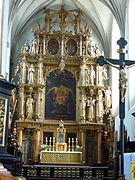Nikolaikirche (Danzig)
The Nikolaikirche is the only Gothic brick church in Gdańsk that did not fall victim to the flames during the fighting in April 1945. After the war, the Catholic Church was taken over by the Polish Dominican Order .
On March 29, 1957, the church was entered in the list of Gdańsk Monuments under No. 51.
history
The first St. Nicholas' Church in Gdansk was probably built around 1185. On January 22nd, 1227 the Pomeranian Duke Swantopolk II gave the church to the monks of the Dominican Order, who were brought to Gdansk by Hyacinth of Poland (Jacek Odrowąż). A monastery building was erected next to the church. The church was consecrated in 1239.
The construction of the current church began after 1384. First the choir with four bays was built , then the three-aisled, six-bay long hall church. The naves were each 37 m long and 16 m high, the choir 25 m long and 9.30 m wide. The buttresses were drawn into the aisles. The church has a gable roof.
In 1487 the church was given a star vault. The vaults rest on ten octagonal pillars. The tower was raised by an octagonal tambour. There are tombs under the floor.
In the course of the Reformation the church was attacked and looted in 1525 and 1576, the monks were driven out, some of them killed.
In 1564 the church was officially handed over to the Evangelicals, the monastery treasury was attached to the town hall. Only after a protest by the Polish King Sigismund II August did the Dominicans get their monastery back in 1567.
On October 11, 1587, King Sigismund III , who had traveled from Sweden . Wasa the certificate of free election after signing the so-called Pacta Conventa on October 7th .
At the end of the 17th century, the Gothic St. Hyacinthus Chapel on the northern side of the choir was rebuilt.
During the Russian artillery bombardment in 1813 the monastery building burned down. In 1834 the Dominicans were expelled from Gdansk. The monastery buildings were demolished. St. Nikolai became a Catholic parish church, which was elevated to a minor basilica in 1929 .
In 1945 the St. Nicholas Church was taken over again by the Dominicans, who had been expelled from their monastery in Lviv by the Soviets . They brought with them the miraculous icon of Mary, which has been in their possession since 1260.
Furnishing
The oldest works of art include the Gothic Pietà from the beginning of the 15th century, the wall painting (around 1430) with the passion scenes on the north wall of the choir, as well as the image of Mary (around 1466) and the choir bar with the crucifix (around 1520). The Gothic choir stalls with rococo backrests are located on both sides of the choir.
The richly decorated high altar was built around 1643 and is in the late Renaissance style. The altarpiece from 1647, a work by the Gdańsk artist August Ranisch, shows St. Nicholas kneeling before Christ and receiving a book from him, as well as Mary, who hands him a miter . The high altar is crowned with a Madonna figure framed by a mandorla .
On the side there are twelve mostly baroque altars. In the south aisle there is a black, marble holy water font from the 18th century. Opposite is a baroque baptismal font (around 1732), based on four evangelist figures.
The baroque organ was modernized in 1977.
literature
- Tadeusz Dobrzeniecki: Architektura sakralna w Polsce na Ziemiach Zachodnich i Północnych. Warszawa: Ars Christiana, 1976, p. 21.
- Franciszek Mamuszka: Gdańsk i okolice: przewodnik. Warszawa: Sport i Turystyka, 1990, p. 95. ISBN 83-217-2585-6 .
Web links
Individual evidence
- ^ Otto Brauer: The Danzig Nikolaikirche. Danzig 1907, p. 9 and 11
Coordinates: 54 ° 21 ′ 7.9 ″ N , 18 ° 39 ′ 7 ″ E







